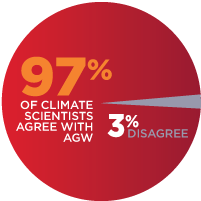The alarmism accusation – claims of crises created to funnel funding
 |
If I warn you about the dangers of red flags, am I an alarmist? |
How to recognise this tactic
Those who use this tactic insist that the current scientific consensus on some issue is corrupt. This, they claim, is because a group of scientists has colluded to hype the position which favours its own interests. The purported motive is to attract funding for their research. Look for derisive terms such as “follow the money” or “pal review”.
No-one gets funded to demonstrate a specific result. People get funded to investigate questions.
Gavin Schmidt, British-American climate modeller and communicator, 2011
The “logic” behind this tactic
The scenario painted by perpetrators of this tactic goes something like this:
- Scientists, desperate for funding, manufacture crises, centred around their own research interests or discipline, to attract funding.
- Grant funding in the field is controlled by established elders (often referred to as a ‘priesthood’) – those who were the leaders in setting up the crisis.
- Lesser scientists who are desperate for funding will propose only research projects that reinforce the accepted crisis position.
- Those who disagree with the prevailing opinion are persecuted and denied funding. Proposals for ‘contrary’ projects are rejected and papers are suppressed.
- The result is that the crisis position becomes the consensus because it is the only position that will receive funding
Why do people use this tactic?
Unfortunately, some people judge scientific issues on the basis of ideology, religion or emotions rather than on the evidence. When the weight of scientific opinion is against them, they resort to questioning its legitimacy. They refuse to accept that there is a scientific consensus, preferring to invent conspiracies or corruption scenarios to argue against its existence. The more generous of them will admit that scientists are well-meaning, but claim that they are unconsciously swayed by the need to finance their research programs.
What’s wrong with this tactic
The “logic” described above displays an ignorance of the way science works. Science projects are designed to investigate how a particular phenomenon actually works, not to confirm some pre-conceived opinion of the way it works. Here’s a good description of how scientific funding operates, from John Mashey at DeSmogBlog:
In real science, scientists: 1. propose a research topic for grant funding, often to government agencies via open, fiercely-competitive processes peer-reviewed by experts who include past performance. Awards are usually publicly visible, as seen at the National Science Foundation(NSF)or National Institutes of Health (NIH). 2. do research, whose outcomes are not predetermined, present results at science meetings and publish in credible science journals, regularly acknowledging funding sources. They may do some outreach for general public, and may even get public exposure, but to be successful they must convince other field experts of their work’s merit. Scientists comprise their primary audience. 3. provide one or more reports to the funding agency listing the papers, talks or other relevant accomplishments. Such reports are usually public, often online.
No scientist would propose a research project that aims to ‘prove’ a certain conclusion. Even when scientists test a particular model to see if it corresponds with reality, they take great care to look for data that would show the model is wrong, not just data that would confirm the model. The default position in model testing is always the null hypothesis – that is, that the explanation being tested is wrong. Only if the data show compellingly that this is not the case will the alternative hypothesis (that the model is supported) be accepted. Consequently, even in the unlikely event that a “priesthood” could select projects favourable to their biases, the projects will not return the favour if their models do not correspond to reality.
What to do when confronted by this tactic
As always, ask for evidence. In this situation, ask for evidence that a handful of “high priests” is controlling the scientific consensus on a particular issue. Don’t accept anecdotes about “pal review” (supposedly a corruption of peer review) or the odd contrarian scientist who has been given the cold shoulder. Everyone knows that the scientific process is not perfect. But for the “corrupt alarmist consensus” argument to be true, there would need to be large-scale, consistent, devious behaviour by large numbers of people. Evidence for that should be easy to find. On the other hand, it’s usually very easy to find statements of support for the scientific consensus from all sorts of national scientific organisations. Ask how these statements can exist if the consensus is corrupt. Once the discussion degenerates to the extent that thousands of people are being accused of clandestine collusion and corruption, you know you are dealing with a conspiracy fantasy.
Variations and related tactics
This tactic is a form of poisoning the well, in which the perpetrator attacks the reputation of an opponent in the hope that you will then regard his arguments as invalid.
Examples
- This tactic is most often employed by those who deny the reality of human-induced climate change. It appears in the comments section of almost any article on climate. Here’s a good example from The Guardian’s Climate Consensus – the 97%:

- Here are some National Science Foundation guidelines for grant proposals to investigate Climate and Large-Scale Dynamics. Notice the list of research topics. No calls for pre-ordained conclusions there.
- Aerospace engineer Willie Soon, a climate contrarian, had no problem finding funding and publishers, even though most climate scientists regarded his research as rubbish (here and here). Soon had no success through normal channels, but obtained funds easily from fossil fuel interests. This raises the question: if climate scientists are so desperate for funding, why don’t they simply follow the same channels as Soon?
- Anti-GMO proponents use a version of this tactic by accusing companies such as Monsanto of controlling the scientific consensus on Genetically Modified crops. Steven Novella discusses an example at NeuroLogica Blog.
Further reading
Taking the Money for Grant(ed) by Scott Mandia at Global Warming: Man or Myth?
Was Willie Soon Paid For Science…Or Anti-Science? by John Mashey at DeSmogBlog.
A Scientific Debate by Bill Ruddiman at RealClimate.
Gavin Schmidt’s quote is from Reflections on funding panels at Realclimate.
The Fan of Euro Notes on Scales image is from TaxRebate.org.uk via Flickr.
| This is one of ScienceOrNot’s Science red flags. See them all here. |










Trackbacks & Pingbacks